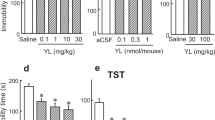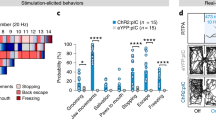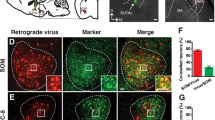Abstract
DURING the past six years a remarkable series of publications has appeared, claiming the transfer of various specific learned behaviours from animal to animal by i.p. injection of extracts made from brains of trained donors. These are cited in the latest paper1, in which Ungar and his colleagues propose an amino acid sequence for a pentadecapeptide isolated from the brains of donor rats trained to avoid a dark box. Injection of this material into untrained recipient mice is alleged to transfer the learned dark avoidance. The molecule has been named scotophobin, after the Greek words meaning “fear of the dark”.
This is a preview of subscription content, access via your institution
Access options
Subscribe to this journal
Receive 51 print issues and online access
$199.00 per year
only $3.90 per issue
Buy this article
- Purchase on Springer Link
- Instant access to full article PDF
Prices may be subject to local taxes which are calculated during checkout
Similar content being viewed by others
Change history
01 April 1973
IN the article "Comments on the Isolation, Identification and Synthesis of a Specific-Behaviour-Inducing Brain Pep-tide" by Avram Goldstein (Nature, 242, 60; 1973) the first sentence of paragraph 2 should read: "The long controversy over the claims for transfer of learned behaviours was reviewed by W.
References
Ungar, G., Desiderio, D. M., and Parr, W., Nature, 238, 198 (1972).
Stewart, W. W., Nature, 238, 202 (1972).
Goldstein, A., Sheehan, P., and Goldstein, J., Nature, 233, 126 (1971).
Ungar, G., in Methods in Pharmacology, chapter 16 (edit. by Schwartz, A.), 1, 479 (Appleton-Century-Crofts, New York, 1971).
Ungar, G., in Symposium on Protein Metabolism in the Nervous System, chapter 29 (edit. by Lajtha, A.), 571 (Plenum, New York, 1970).
McGaugh, J. L., Science, 153, 1351 (1966).
Ungar, G., Table 2.3 in “Bioassays for the Chemical Correlates of Acquired Information”, in Chemical Transfer of Learned Information, North-Holland Research Monograph, Frontiers of Biology (edit. by Fjerdingstad, E. J.), 22, 36 (North-Holland Publishing Co., Amsterdam, 1971).
Author information
Authors and Affiliations
Rights and permissions
About this article
Cite this article
GOLDSTEIN, A. Comments on the “Isolation, Identification and Synthesis of a Specific-behaviour-inducing Brain Peptide”. Nature 242, 60–62 (1973). https://doi.org/10.1038/242060a0
Received:
Revised:
Issue Date:
DOI: https://doi.org/10.1038/242060a0
This article is cited by
-
Is chemical memory transfer due to shock or behavior training?
Experientia (1978)
-
Effect of long-term shock-avoidance training on certain biochemical constituents of rat brain
Proceedings / Indian Academy of Sciences (1978)
-
The problem of molecular coding of neural information
Die Naturwissenschaften (1973)
Comments
By submitting a comment you agree to abide by our Terms and Community Guidelines. If you find something abusive or that does not comply with our terms or guidelines please flag it as inappropriate.



